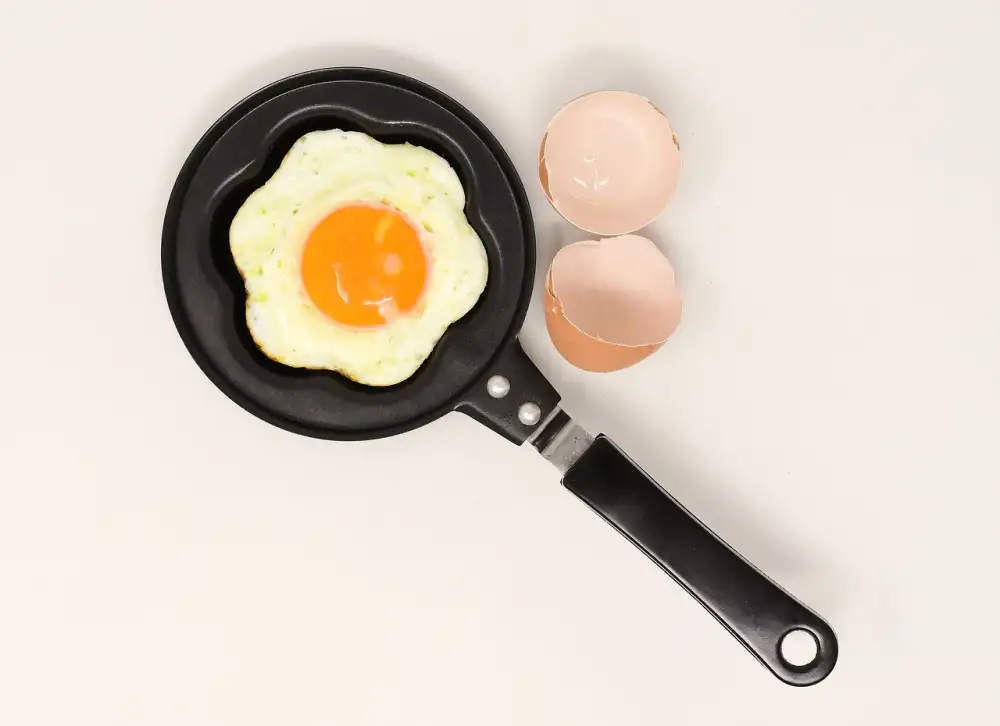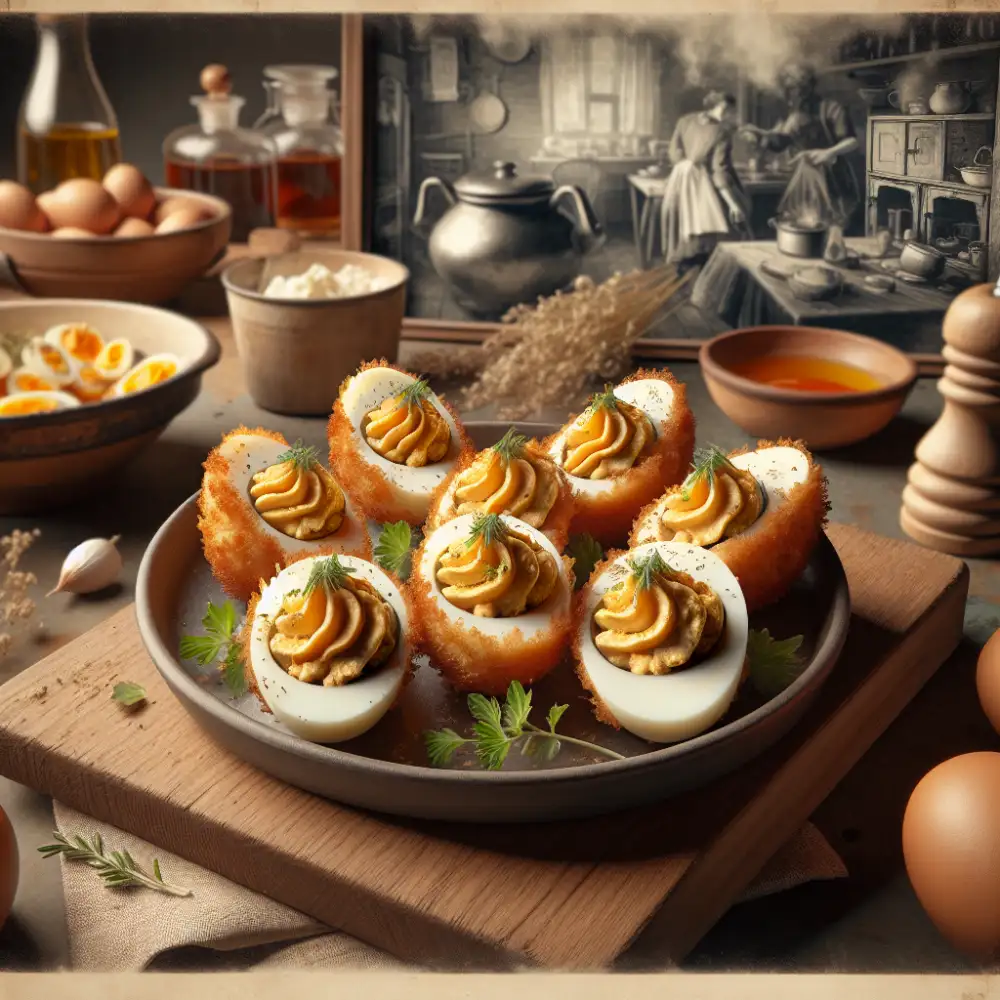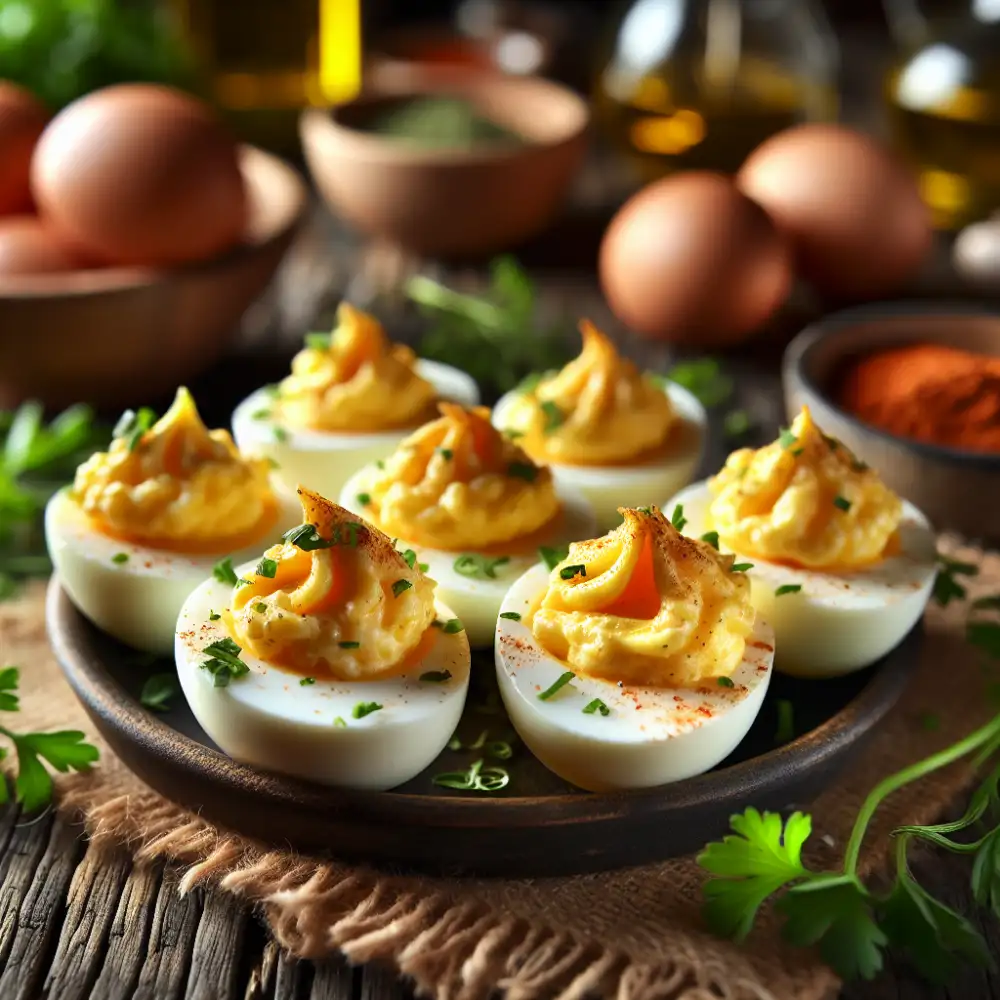Crispy Golden Goodness: Must-Try Fried Deviled Eggs Recipe

Ingredients
For the classic fried deviled eggs, you'll need: a dozen large eggs, mayonnaise, yellow mustard, sweet pickle relish, paprika, salt, and black pepper to taste. For a crispy coating, prepare all-purpose flour, beaten eggs, and panko breadcrumbs.
If you're feeling adventurous, try a spicy variation. Swap the sweet pickle relish for chopped pickled jalapeños. Add a pinch of cayenne pepper to the yolk mixture for an extra kick. Instead of the classic panko breading, consider using crushed tortilla chips for a Tex-Mex twist.
No matter your chosen variation, always use fresh, high-quality ingredients. Opt for organic, free-range eggs if possible. Freshly ground black pepper and a sprinkle of smoked paprika elevate the flavor profile. Remember, the key to delicious fried deviled eggs is a perfect balance of creamy, tangy, and crispy.
Hard-boil the eggs
For perfectly cooked yolks that are easy to mash, you'll want to hard-boil your eggs. Place the eggs in a single layer in a saucepan and cover them with cold water. The water should be about an inch above the eggs. Bring the water to a rolling boil over high heat. Once the water is boiling, turn off the heat and cover the pot with a lid. Let the eggs sit in the hot water for the following times, depending on your desired yolk texture: 9 minutes for firm yet slightly creamy yolks, 10 minutes for classic hard-boiled yolks, or 11-12 minutes for very firm, crumbly yolks.
| Feature | Classic Deviled Eggs | Fried Deviled Eggs |
|---|---|---|
| Texture | Smooth, creamy | Crispy exterior, creamy interior |
| Flavor | Tangy, savory | More intense savory flavor, potential for added seasonings in breading |
| Preparation | Simpler, quicker | Additional steps for breading and frying |
After the timer goes off, immediately drain the hot water and place the eggs in an ice bath. This stops the cooking process and prevents that undesirable greenish ring from forming around the yolk. Let the eggs cool in the ice bath for at least 15 minutes before peeling. Peeling the eggs under cold running water can make the process easier. Now that you have your perfectly hard-boiled eggs, you can start creating your deviled egg filling!
Prepare the yolk mixture
To prepare the yolk mixture for your fried deviled eggs, start by gently separating the cooked egg yolks from the whites. Place the yolks in a mixing bowl and set the whites aside for later. Now, add your preferred creamy base to the yolks. Mayonnaise is a classic choice, but you can also experiment with Greek yogurt, sour cream, or a combination for a lighter twist.

For that extra flavor punch, incorporate your favorite seasonings. Mustard, whether Dijon or yellow, is a must-have for that tangy kick. A dash of hot sauce can add a pleasant heat, while sweet pickle relish introduces a sweet and tangy element. And of course, don't forget a generous sprinkle of salt and black pepper to enhance all the flavors.
Once you've added your seasonings, use a fork to thoroughly mash and blend the yolks with the other ingredients until you achieve a smooth and creamy consistency. If you prefer a smoother texture, you can also use a potato masher or even a food processor for this step. The key is to ensure that the yolk mixture is well combined and free of any lumps.
Carefully peel the eggs
For perfectly peeled eggs, don't use fresh ones! Eggs that are a week or two old peel much easier. To start, gently tap each boiled egg on the counter to create cracks all around the shell. Submerge the cracked eggs in a bowl of ice water for about 10 minutes. The cold water helps to separate the membrane from the egg white, making peeling a breeze.
Now, here's a little trick: Peel your eggs under running water! The stream of water helps to further loosen the shell and makes the whole process much smoother. Once peeled, pat your eggs dry with a paper towel before slicing them in half lengthwise.
Remember, the smoother the egg white, the better your deviled eggs will look, especially when you're going for that extra-crispy coating from frying! So, take your time and peel carefully.
Fried deviled eggs? Oh, you mean little bites of crispy, creamy, tangy heaven.
Elara Nightfall
Fill the egg whites
Once your yolk mixture is perfectly seasoned and smooth, it's time to fill those crispy egg white shells. You can use a spoon for a more rustic look, but for a touch of elegance and precision, piping the filling is the way to go. A piping bag fitted with a star tip creates beautiful, restaurant-quality deviled eggs.
Hold a fried egg white half in your hand and gently pipe the yolk mixture into the cavity, mounding it slightly. Repeat with the remaining egg whites and filling. For an extra burst of flavor, consider topping your fried deviled eggs with a sprinkle of paprika, a dash of hot sauce, or even a dollop of guacamole. Fresh herbs like chives or parsley add a vibrant pop of color and freshness. Remember, this is your culinary masterpiece, so feel free to experiment with different toppings and flavor combinations to create your signature fried deviled eggs.
Bread the stuffed eggs
For that extra bit of indulgence and a crispy exterior, you can take your deviled eggs to the next level by breading and frying them. This process transforms the creamy, tangy filling into a hot, molten center, while the breading adds a delightful crunch.

Start by chilling your stuffed eggs thoroughly. This will help them hold their shape during the breading and frying process. Set up a breading station with three separate dishes: one with seasoned flour, another with beaten eggs, and the last one with breadcrumbs (panko breadcrumbs work particularly well for a crispier texture).
Carefully dredge each chilled deviled egg first in flour, then dip it in the egg wash, ensuring it’s fully coated. Finally, coat it evenly with breadcrumbs, gently pressing them so they adhere. Once breaded, you can fry the eggs immediately or freeze them for later.
To fry, heat a neutral-flavored oil like canola or vegetable oil in a deep skillet or pot to about 350 degrees Fahrenheit. Carefully lower the breaded eggs into the hot oil, working in batches to avoid overcrowding. Fry them for about 2-3 minutes, turning occasionally, until they are golden brown and heated through.
Remove the fried deviled eggs with a slotted spoon and place them on a wire rack or paper towel-lined plate to drain excess oil. Serve them immediately while hot and enjoy the explosion of flavors and textures.
Heat the frying oil
For perfectly fried deviled eggs, the oil temperature is crucial. Too low, and your eggs will soak up grease and turn soggy. Too high, and you'll have a burnt exterior and a cold, unset filling. Aim for a consistent 350 degrees Fahrenheit (175 degrees Celsius). Use a deep-fry thermometer for accuracy, or if you don't have one, drop a small amount of batter into the oil. It should sizzle immediately and rise to the surface, indicating the oil is ready.
While classic deviled eggs are delightful, consider venturing into the realm of fried deviled eggs for a unique twist. After preparing your deviled egg filling, carefully coat each egg half in breadcrumbs, ensuring a complete and even coating. This breadcrumb layer will provide a satisfying crunch and help hold the egg together during frying. Gently lower the coated egg halves into the hot oil, working in batches to avoid overcrowding the pan. Fry for about 2-3 minutes, turning occasionally, until they achieve a beautiful golden brown color. Remove them with a slotted spoon and place them on a wire rack or paper towel-lined plate to drain excess oil.
Fry until golden brown
For perfectly golden brown and crispy deviled eggs, heat your oil to the right temperature. Too low, and the coating will turn soggy. Too high, and you risk burning the delicate egg white before the yolk mixture inside has a chance to heat through. A deep-fry thermometer is your best friend here, aiming for around 350°F (175°C).
Gently lower each coated deviled egg half into the hot oil, ensuring not to overcrowd the pan. This allows for even cooking and prevents the temperature from dropping too drastically. Fry for about 2-3 minutes, turning occasionally, until they reach that beautiful golden brown hue. Remember, we're looking for a crispy exterior, not overcooked yolks. Once done, remove them with a slotted spoon and place them on a wire rack or paper towel-lined plate to drain any excess oil.

Now, let's talk variations! For a fun twist, try rolling your coated deviled eggs in panko breadcrumbs before frying. This adds an extra layer of crunch that's simply irresistible. Alternatively, you can experiment with different seasonings in your breading, like smoked paprika, garlic powder, or even a touch of cayenne pepper for a spicy kick.
Drain on paper towels
Fried deviled eggs, whether they're dredged in breadcrumbs or dipped in batter, can be a messy endeavor. The filling itself, a creamy mixture of mashed yolks, mayonnaise, and seasonings, can easily stick to your fingers. And once the eggs are fried, they'll be coated in a layer of hot oil. All of this adds up to one thing: a potential mess. That's where paper towels come in.
Before you even start assembling your deviled eggs, lay out a few paper towels on your work surface. This will give you a place to set down your filling spoon and any stray bits of yolk or filling. Once your deviled eggs are assembled, use a fresh paper towel to gently pat them dry. This will help the breading or batter adhere better.
After frying, transfer the deviled eggs to a plate lined with paper towels. This will absorb any excess oil and help them crisp up nicely. And when it's time to serve, be sure to have a stack of paper towels on hand for any messy fingers. Trust us, your guests will thank you.
Serve immediately
Fried deviled eggs are best enjoyed immediately after cooking. The frying process gives the egg white a crispy exterior while keeping the yolk mixture warm and creamy. This contrast in textures and temperatures is what makes this appetizer so delightful, and it's best experienced fresh.
Waiting too long to serve will cause the whites to soften and lose their satisfying crunch. The filling can also become denser as it cools, diminishing the overall enjoyment. For optimal taste and texture, arrange the fried deviled eggs on a platter and serve them as soon as they are cool enough to handle.
Consider preparing a smaller batch if you're not expecting to serve them immediately. Alternatively, you can pre-boil and devil the eggs, leaving the frying step for the last minute. This way, you can still impress your guests with a piping hot and crispy appetizer without compromising on quality.
Published: 27. 06. 2024
Category: Food



